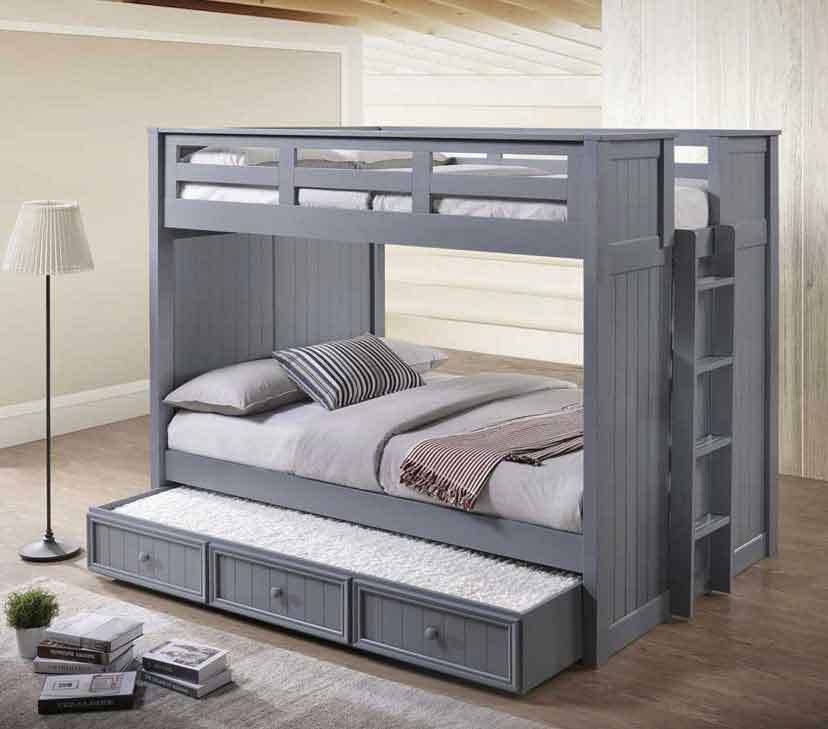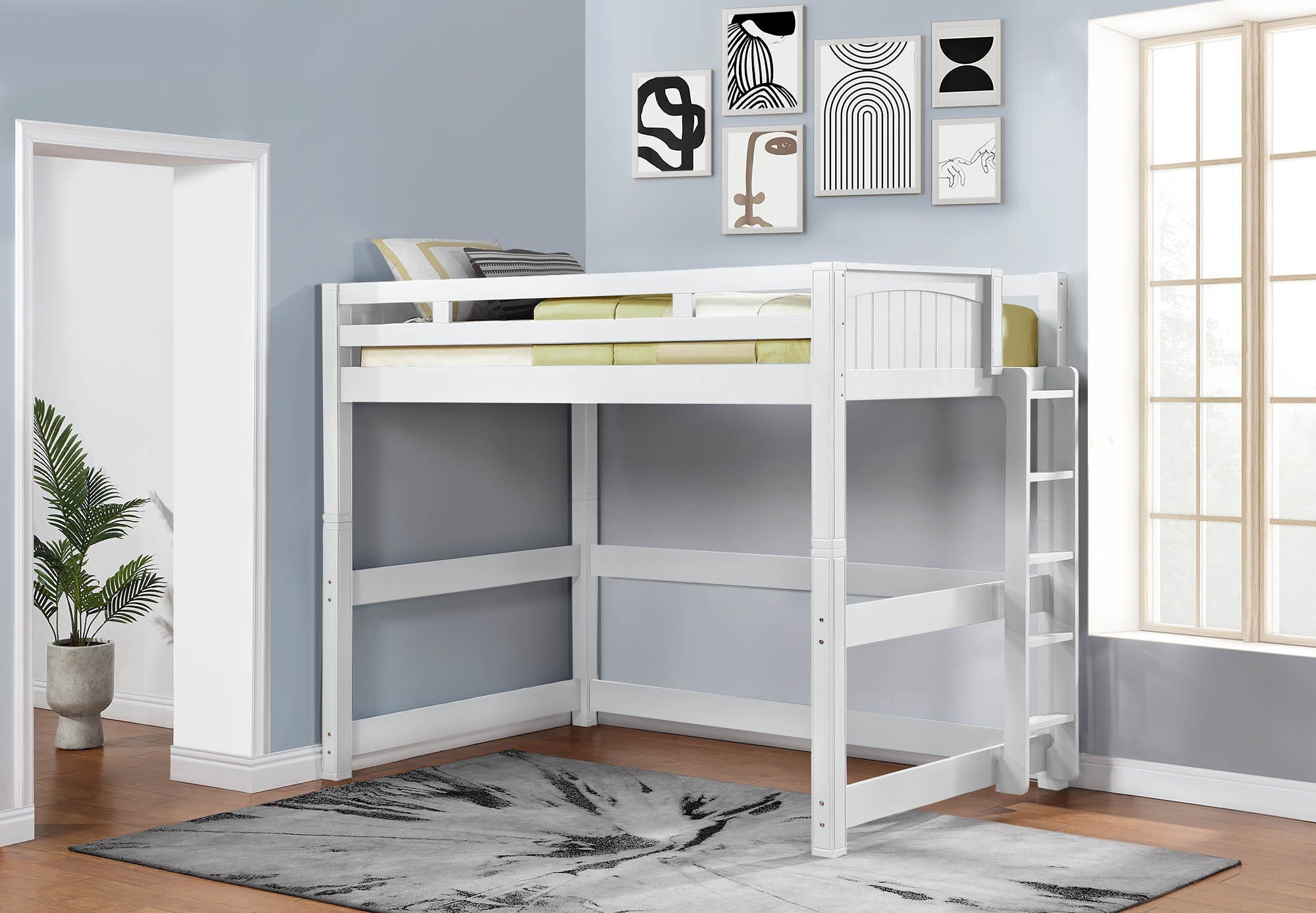Can an Adult Fit in a Bunk Bed?
Posted by UPW on Mar 28th 2025

Bunk beds were originally built for children—smaller frames, lighter loads, and simple setups made them a logical fit for kids’ rooms. But over time, their purpose has grown. Today, adult-sized bunk beds are used in vacation homes, staff housing, guest rooms, and rental properties, serving adults just as often as kids.
With that shift, it’s reasonable to ask whether bunk beds are truly built for adult use—especially when it comes to size, support, and structural safety. So, are bunk beds safe for adults?
Can Bunk Beds Be Used for Adults?
Yes, adult bunk beds are specifically engineered to meet the physical requirements and lifestyle habits of grown users. Unlike children’s models, these beds are constructed to handle larger body weights, longer limbs, and more frequent usage.
Exploring the Versatility of Modern Bunk Bed Designs
Adult bunk beds are no longer limited to just two stacked beds—they’re engineered as practical, multi-use furniture pieces tailored to specific adult routines and sleeping needs. From thoughtful ladder placement to built-in storage options, the construction of these beds is intentional, not decorative. When choosing your bed, the details matter—whether you need easier access to the top bunk, additional support while sleeping, or integrated features to help you stay organized.
Here are several modern features that make bunk beds suitable for adult users:
- Extended Headroom: Taller bed openings between bunks give you the space to sit upright comfortably without bumping your head, a significant upgrade from lower-clearance youth models.
- Integrated Storage Solutions: Under-bed drawers, staircase storage compartments, or built-in shelving help you store bedding, clothes, or personal items without needing extra furniture.
- Staircase Access Options: Some beds feature wide staircases instead of ladders. These stairs are more stable under adult weight and often include pull-out drawers within each step.
- Solid Hardwood or Metal Frames: Choose from metal frames for a minimal, modern feel or hardwoods like oak and walnut that offer durability and classic appeal. Both materials are rated for adult use and high-load scenarios.
- Loft Configurations with Desks or Seating Areas: Perfect for compact apartments or shared rooms, loft beds combine a top bunk with a functional lower area, creating a dedicated workspace or seating zone underneath.
These features aren't just add-ons—they’re designed with purpose. For adult users, the right bunk bed offers a reliable sleeping surface, easier mobility, and thoughtful additions that improve room usability.
How Much Weight Can Adult Bunk Beds Hold?
There is no federally mandated minimum weight capacity specifically outlined for adult bunk beds. Still, manufacturers are required to certify compliance through a General Certificate of Conformity (GCC), based on product testing or a reasonable testing program. Because of this, weight limits vary by model and manufacturer.
Some adult bunk beds are rated as low as 250–350 lbs. per bunk, while others are built to handle up to 2,000 lbs. in combined static load. Always verify the published weight rating from the manufacturer before purchasing.

Is it Safe for an Adult to Sleep on the Top Bunk?
Yes, when properly constructed and installed, adult bunk beds are safe for top-bunk use. However, that safety depends on more than just the materials used—it requires compliance with specific build standards and proper usage habits.
Sleeping on the top bunk as an adult introduces different physical considerations than it does for children, such as weight distribution, ladder stability, and mattress height. Choosing a bed that meets industry benchmarks and using it the right way can significantly reduce risks and help maintain long-term structural integrity.
Safety Standards and Guidelines for Adult Bunk Beds
Not all adult bunk beds are created equal, and meeting voluntary or mandatory benchmarks is essential—particularly for top bunk usage. Standards from organizations like ASTM International (F1427) and 16 CFR Part 1213 issued by the Consumer Product Safety Commission (CPSC) help ensure that adult bunk beds meet minimum thresholds for structural safety, entrapment prevention, and guardrail security.
Meeting compliance standards is a strong foundation, but day-to-day use plays an equally important role in keeping the top bunk safe. Even with a well-constructed bed, small decisions like where the bed is placed or what mattress you use can affect safety.
Guardrail Coverage and Height
The upper bunk must include guardrails on both sides, with the top edge of the rail positioned at least 5 inches above the mattress surface when the thickest recommended mattress is used. This helps prevent accidental roll-offs during sleep.
Rail Openings and Gap Control
Any openings in or under the guardrails must be small enough to prevent a head or limb from becoming trapped. The maximum spacing between parts of the rail should not exceed 3.5 inches, reducing the risk of entrapment.
Secure, Non-Removable Guardrail Fastening
Guardrails must be fixed in place using secure hardware that either requires tools for removal or has a two-step release mechanism. This ensures that the rail cannot come loose or detach unintentionally.
Ladder Integration and Stability
Ladders must be securely attached to the frame using durable hardware. They must not shift or detach during use and should support repetitive adult use without degrading or becoming loose over time.

Proper Mattress Fit and Placement
Mattresses must sit firmly within the frame without large gaps on the sides. They should also stay within the recommended thickness range to preserve guardrail effectiveness—too tall a mattress can eliminate the protective height of the rails.
Choose a Bed with Angled or Built-In Stairs
Staircase bunk beds or models with angled ladders offer more stability than vertical ladders. Wide treads and handrails add traction and help reduce slipping during use, especially at night or in low lighting.
Ensure Proper Ceiling Clearance
The top bunk should allow at least 30–36 inches of space from the top of the mattress to the ceiling. This gives you enough room to sit up without hitting your head and helps with safe entry and exit.
Limit Overhead Fixtures and Wall Hazards
Avoid placing top bunks under ceiling fans, low beams, or near shelves and hard-edged furniture. Unexpected contact with these during sleep or movement increases the risk of injury.
Maintain Ladder and Rail Fasteners
Inspect and tighten screws, bolts, and brackets on ladders and guardrails regularly. Over time, movement and repeated use can loosen hardware, which can go unnoticed until it creates a hazard.
These precautions don’t just improve safety—they also help extend the life of your bunk bed by reducing unnecessary strain on structural points. For adult users especially, being intentional about how the bed is installed and maintained makes a meaningful difference.
Can Two Adults Sleep in a Bunk Bed?
Yes, two adults can safely and comfortably sleep in a bunk bed—as long as the bed is built to support the combined weight, body dimensions, and usage patterns of multiple adult sleepers. Not all bunk beds are designed for shared use, so the size, configuration, and construction of the frame matter.
- Twin XL over Twin XL - This configuration adds 5 inches of length compared to a standard twin, making it more suitable for tall adults. With 38 inches of width, each level supports one adult, making it ideal for compact rooms where individual bunks are preferred.
- Full over Full - At 54 inches wide, each bunk can fit two smaller adults or one adult comfortably. This size is often used in short-stay properties or guest rooms that need flexible sleeping arrangements without the footprint of a queen.
- Queen over Queen - Offering 60 inches of width and 80 inches of length per bunk, this setup is well-suited for two adults on each level. It's a common choice in Airbnb's, cabins, or shared living environments where group stays are frequent and space needs to be maximized without separate beds.
- Twin over Queen / Full over Queen - These hybrid formats combine a narrower upper bunk with a more spacious lower bunk, allowing you to sleep one person on top and two below. They work well in guest accommodations or multi-use rooms where occupants may change often.
- Triple and Quad Bunk Beds - Designed for high-capacity use, these frames are configured either vertically or in an L-shape to sleep three to four adults. Reinforced with thick posts, extra-wide ladders, and upgraded support systems, they’re used in group housing or vacation homes hosting larger parties.

When choosing your bed, look beyond just size—confirm that the frame is rated to support the combined weight of all sleepers on each level, especially for shared bunks. Many adult bunk beds list weight capacities between 800 and 2,000 lbs. per level, depending on materials and construction.
Opt for a model with reinforced joints, full-length slats, and clearly defined support specs. With the right setup, a bunk bed can easily and reliably accommodate two—or more—adult sleepers without compromise.
Avoid assuming that any bunk bed will do; performance and longevity start with the right build. For bunk beds that meet real-life requirements, browse Just Bunk Beds or contact us for help selecting the right model for your space.

